Are your competitors ranking higher than you in search results?
This doesn’t mean your content is worse. Often, the difference is due to SEO strategy.
They might be targeting keywords that attract more traffic, or they could rank for keywords you have not included in your content.
This is why competitor keyword tracking is important. So, keep reading to learn more about the importance of competitor keyword tracking in SEO, along with actionable steps to implement it!
Why is Competitor Keyword Tracking Important in SEO?
When you want to improve your position on SERPs, you also need to watch how your competitors are positioning themselves.
Pay attention to the keywords they use and how they use them. By looking at your competitors’ keywords, you can gain valuable insights into their marketing strategies. This will also help you to
- shape your future SEO approach,
- find content gaps,
- attract more traffic to your website.
Tracking competitors’ keywords also helps you see which topics and content types get the most engagement in your industry or niche.
Remember that competitor keyword tracking should be a continuous process because SERPs are highly competitive and keyword rankings tend to change over time.
How to Do Competitor Keyword Tracking
Now that you know about the SEO importance of competitor keyword tracking, let’s turn to the practical steps of tracking.
Identify Your Competitors
First, it’s important to define and narrow down your competitors. Remember that your SEO competitors are not always your direct business competitors. Sometimes, they can be websites, blogs, or online publications that rank for the same keywords as you.
There are several ways to see who your competitors are on search engines.
First, use Google, of course. Where else can you identify your SEO competitors if not on the most widely used search engine? A simple Google search with keywords relevant to your industry is by far the fastest way to identify your competitors, the keywords they target, and any other useful information.
Step 1: Go to Google
Step 2: Type in a couple of keywords that are relevant to your industry. Try several different keywords (such as industry-specific narrow keywords, local keywords, or broader industry keywords) to track which competitors tend to appear in the top 10 more frequently.
Step 3: Filter down these websites and carefully examine their content to further refine your SEO strategy.
Let’s have a look at an example below. Imagine you are an agency providing link-building services. Try searching for keywords such as “link-building services” or, more locally, “link-building services in [city, location]”.

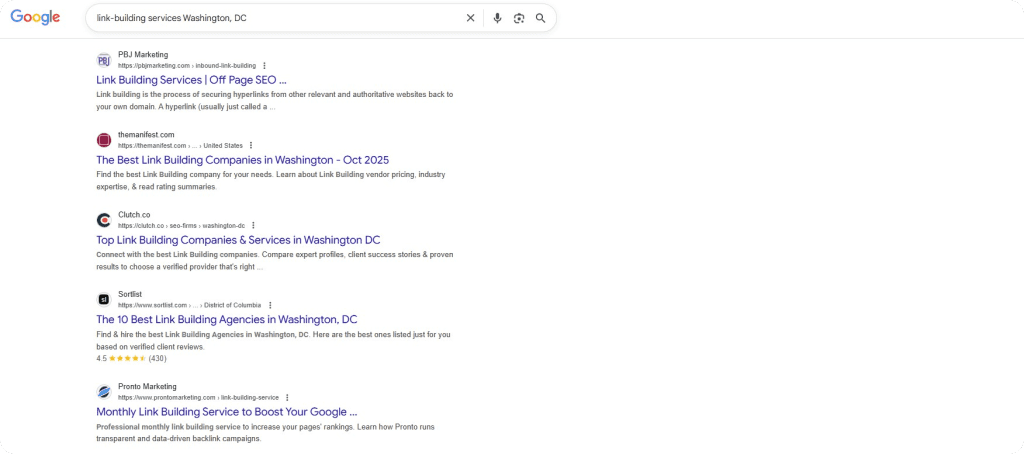
Apart from Google, you can also utilize different SEO tools (such as Ahrefs, SEMrush, Moz, SE Ranking, SpyFu) to check the list of your competitors.
One of such popular and practical tools is Ahrefs.
Here’s how you can find your competitors using Ahrefs.
Step 1: Go to Ahrefs
Step 2: Enter your website’s domain into the “Site Explorer” search bar.
Step 3: Look for the “Organic competitors” report in the left-hand menu.
Step 4: Review the list of domains that have an overlap in your organic keyword rankings.
Here, you will also have an overview of:
- Competitor’s keywords: Organic keywords that a competitor is ranking for, but your target isn’t.
- Common keywords: Organic keywords that both your target and a competitor are ranking for.

Analyze and Compare Competitor Keywords
Now that you know your competitors, have a look at the keywords they are ranking for.
You can first get an overall picture of all the keywords your competitors rank for. This will give an initial understanding of your competitors’ content strategy.
To see the overall ranking of your competitors’ keywords:
Step 1: Go to Ahrefs’ “Site Explorer”
Step 2: Enter your competitor’s domain
Step 3: Go to the “Organic keywords” reportStep 4: On the left side, check for the keywords your competitor ranks for. You can also see the search volume and keyword difficulty for each of the ranking keywords.
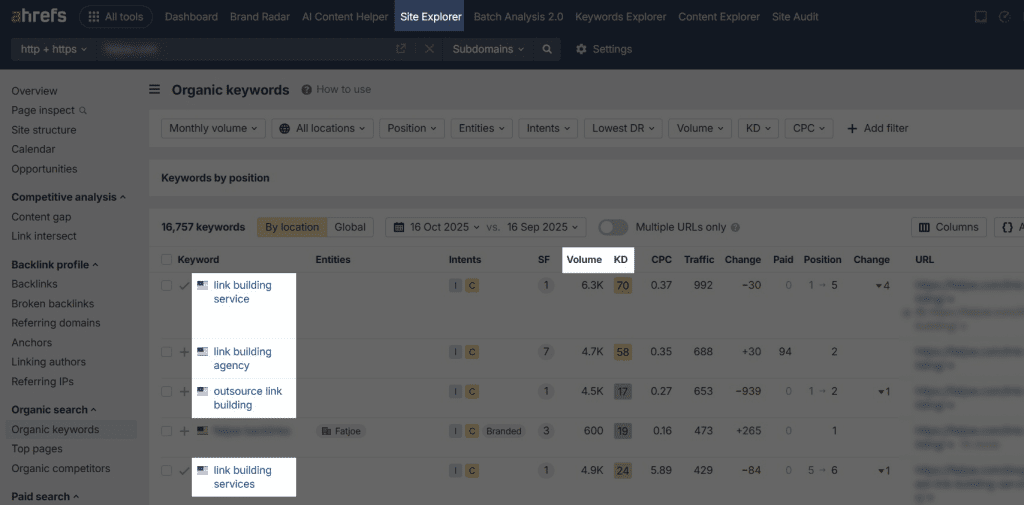
However, for more effective competitor keyword tracking, it is important to compare your and your competitors’ keywords and identify whether or not they have ranking keywords that you have missed. This will help you with filling your content gaps.
Many SEO tools can help you find the keywords your competitors are ranking for that you haven’t targeted yet.
Let’s take Ahrefs again and follow these steps to see the content gap between you and your competitors.
Step 1: Go to Ahrefs
Step 2: Enter your URL in the “Site Explorer” section
Step 3: Choose “Content Gap” on the left bar
Step 4: Enter the names of one or more URLs of your competitors
Step 5: Hit “Show keyword opportunities”
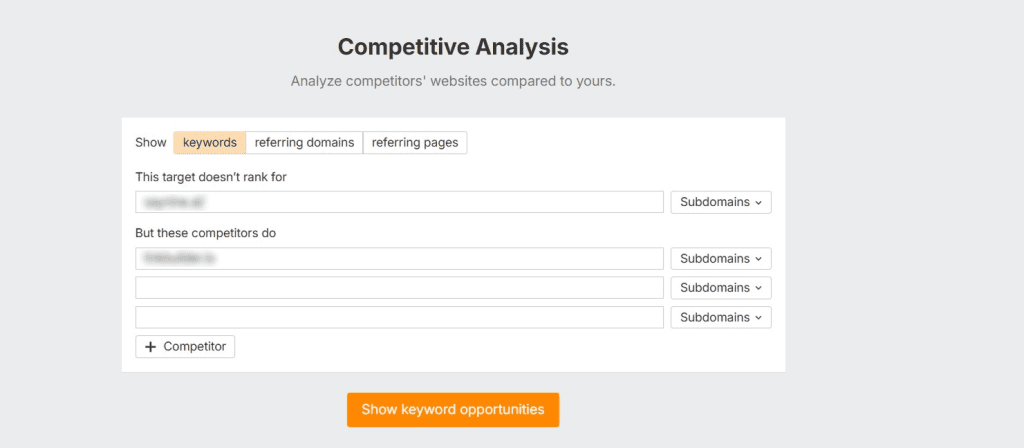

Now you will get a full list of keywords your competitors rank for, but you don’t.
Pay close attention to keyword metrics, such as search volume and keyword difficulty. You can filter these metrics based on your goals (through the “Add filter button”).
For an easier analysis, you can even extract the results in different file formats by clicking the “Extract” button in the right corner.
Tip: To keep track of competitor keywords and their change over time, consider compiling them in a spreadsheet and updating it over time. Enter competitor websites, names, and keywords they rank for.
Analyze Competitors’ Content
Now that you have the list of keywords your competitors rank for, you can open their content and start analyzing to further refine your own content strategy according to this information.
When analyzing your competitors’ content, make sure to:
- Check how the keywords are used in their content. Are they short-tail or long-tail? How are they distributed throughout the content? Which keywords are used more frequently?
- Check the important metrics such as keyword difficulty and search volume.
- Check what their search intent is. Are the results navigational or informational?
- Check the meta titles, meta descriptions, as well as headings of the top results. How are the keywords used here?
- Check their overall content. Maybe they have covered interesting and unique topics that you haven’t covered before? This will provide fresh insights and further inspiration for your content.
For a deeper approach, again, consider using SEO tools to conduct competitor content analysis.
On Ahrefs, you can do so by following these steps:
Step 1: Go to Ahrefs’ “Content Explorer” section
Step 2: Enter your competitors’ domain in the search bar
Step 3: You’ll now see a list of all content from that domain with all the necessary metrics for each piece of content, such as referring domains, organic traffic, and social shares.
Through the “Add filter” button, you can also sort the results according to domain rating, referring domains, website traffic, and many other filters.
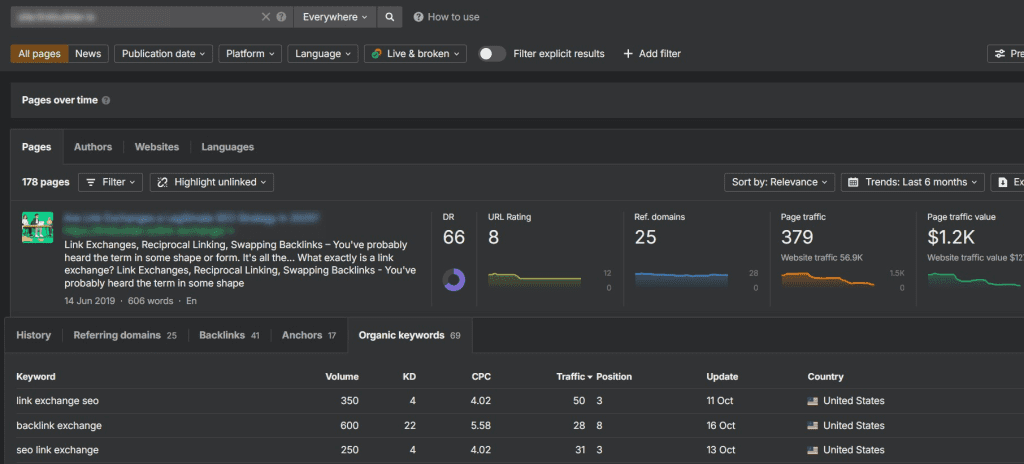
Now that you see the results, go on analyzing individual contents by clicking on any title to open detailed metrics for that specific post. Here, you can see all the top keywords that drive traffic to that post, the number of backlinks and referring domains, as well as organic traffic trends.
Refine Your Content Strategy and Monitor Performance
As the final stage of competitor keyword tracking, it’s time to fill your own content gaps.
Based on these insights, turn to optimizing your existing content by updating information, improving readability, and adding relevant keywords to boost performance.
After 2-3 months, don’t forget to track whether your content optimization is bringing any results.
Regularly review important content performance metrics such as:
- page views and organic traffic,
- keyword rankings,
- engagement,
- conversion rate.
Here too, SEO tools come to help. On Ahrefs, for example, you can see all the necessary metrics by following these two simple steps:
Step 1: Go to Ahrefs’ “Site Explorer” section
Step 2: Enter the content URL you want to track the metrics of. This will give an overview of the monthly search traffic that the page is receiving.
- By clicking on the “Organic keywords” section on the left side, you will be able to see all the keywords your blog post ranks for with their positions, search volume, and keyword difficulties.
- To see how many websites are linking to your post, go to the Backlinks or Referring Domains report.
To compare your blog’s performance against competitors, just click on the “Content gap” section and add your competitors’ URLs to check if their pages/blogs are ranking better than yours.
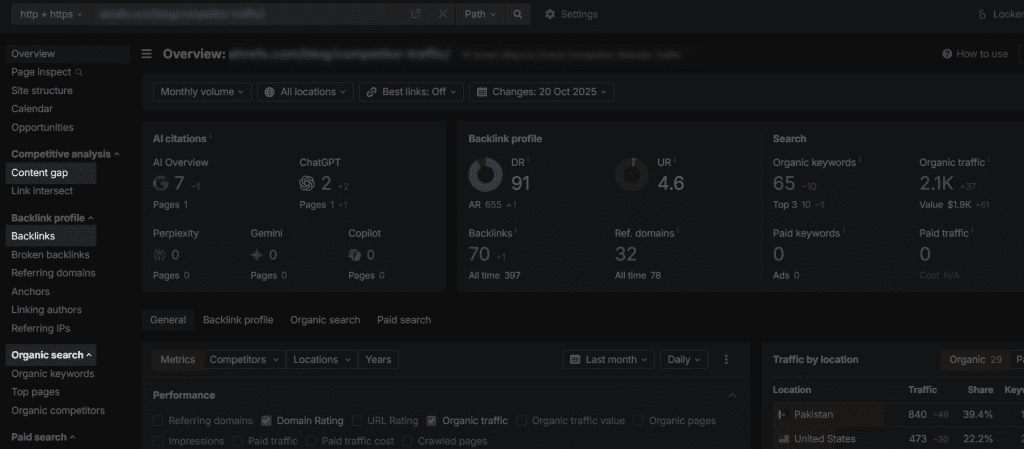
A periodic performance tracking of your content ensures it stays relevant, competitive, and effective in reaching your business goals.
Conclusion
If you see that your competitors are ranking higher than you, take it as a sign to begin competitor keyword tracking right away.
Use Google and different SEO tools to find out who your competitors are, discover the keywords they are focusing on, and look at their overall strategy.
By knowing where they are doing well, you can change your own strategy, address content gaps, and improve your pages for better results.
The sooner you take action, the quicker you can turn this information into real results and get ahead of the competition.